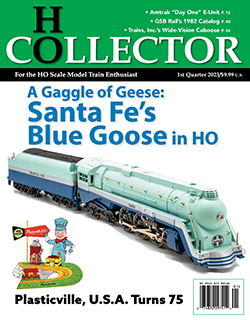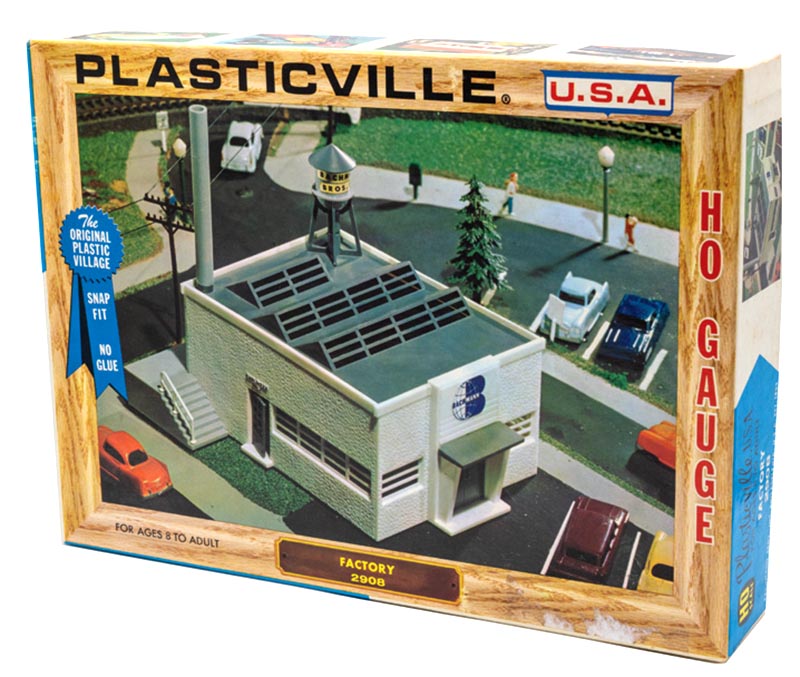 by Tony Cook/photos by the author
by Tony Cook/photos by the author
In October 1952 Railroad Model Craftsman, readers found news of several new products listed in the “Shoppers Digest” section on page 46. A very noteworthy event in hobby history appears on the bottom of the center column under the heading “Plastic HO Buildings.” A short paragraph shares the following… Plasticville U.S.A. have entered the HO gauge field with a series of detailed structures. First models include a combination passenger and freight station, fire house, police station, ranch house, and fence and gate, all in knock down kit form. The complete set of 1/8-inch scale models retails for $3.59. With this announcement a hobby favorite was in HO — a sure signal that 1:87 model railroading was the up and coming scale to watch. Bachmann traces the O-S Plasticville, U.S.A. line to 1947 (recently marking 75 years), while HO just passed 70 years.
I believe I lacked a degree of appreciation for the Plasticville, U.S.A. line of kits. Growing up in the 1970s, I was spoiled by the many structure kits on the market (with Pola-made releases being prime examples of what I knew well and built many samples of for my HO pike). While I did have several Plasticville structures, I don’t recall them being something I paid special attention to and I did not understand their relevance in the hobby. Today, I have a great respect for this series and enjoy adding examples to my collection. These kits are landmark offerings, as they helped usher in injection-molded plastic component structure kits to model railroading in HO scale. The simplicity of the design, affordability, and availability help new hobbyists in the 21st century begin populating towns and cities. I’m impressed when I see a basic Plasticville kit given weathering and other attention by a serious hobbyist. Not long ago, I saw a post on a Facebook group that shared an amazing effort applied in the process of creating a very realistic addition to a railroad using the Coaling Station kit.

ABOVE: This Plasticville, U.S.A. Railroad Station Kit should be very familiar to any reader of HO Collector. This HO-scale release first appeared a 70 years ago. The line was already established with larger (O and S) scale kits in 1947, when five HO offerings joined the series in late 1952. Bachmann’s 75th anniversary relates to the 1947 debut. Though the kits remain largely unchanged over the many years they have enjoyed availability in the hobby; packaging is an area on which collectors can concentrate and be rewarded with a wide range of designs and styles for this line.
There is far too much Plasticville, U.S.A. history to tackle across a handful of pages. My goal with this article is to highlight HO’s early years and give some general points of interest for the reader. If you are a current fan and follower of what was billed as “the original plastic village,” then this piece will mostly be entertainment; however, if you and are well versed in the line’s origin and history, I hope you come away with a new appreciation (similar to what I’ve developed over the years) and begin taking a fresh look at these important kits.
Postwar Boom: 1950s and Beyond
Just as the American landscape was transforming in the years after World War II, the same situation was replicat-ing in HO with new construction of plastic taking its place on pikes in and around older-style buildings made of a variety of materials. The line’s annual catalogs (beginning with 1953) divide with O-S and HO publications. The first of the HO series of catalogs appears in 1953 and is labeled “HO-A.” This lettering approach appears to end with 1961’s “I” catalog. The early numbering of HO kits runs from the early 1950s through 1956. The 2000-series numbering reigns into the 1980s. (The 3000-series for carded or blister-packaging is introduced in 1962 and appears to last until about 1970.)

ABOVE: This Factory (2908) release is a “must have” in the Plasticville, U.S.A. line and comes in several incarnations. The model is listed as “new” for 1959 and then carried a 2801 stock number. This early version included “Plasticville Mfg. Co.” in raised letters on the face of the factory above the entry. By the mid-1960s (and still listed as 2801 for boxed and 3801 for blister pack issue), the factory received Bachmann branding (the tooling was revised to a flat surface for a sticker to reside showing the logo). This logo was updated a few times over the years, which makes for a minimum of four known variants.
This is a great era to stake out and make a collecting priority. I enjoy the 1950s open-lid boxes. If you are more familiar with the later two-piece cardboard packaging, you may be surprised at how small some of these early boxes can be. I recall receiving a 1950s-era boxed Movie Theatre and was convinced it couldn’t possibly be contained in its approximately 4 x 7-inch container… but it was! These early packages are interesting and fairly easy to obtain. There are several uncommon releases that you might pay a bit for, but by and large you’ll be able to amass a respect-able sampling of these box styles with-out expending much money or effort in locating them. There are several styles of the colorful box design that all seem to inhabit the same small package…



